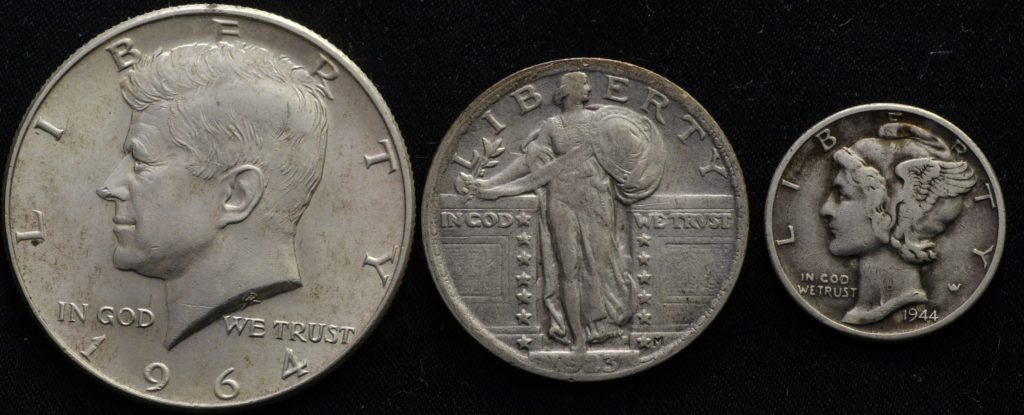Until 1965, United States quarters, dimes and half dollars contained 90% silver and 10% copper. These coins today are known as “junk silver” or 90% silver.
These coins are, quite possibly, the most easily-confused items we sell. Why? Their statutorily defined unit is $1,000 face value (4,000 quarters, 10,000 dimes, or 2,000 halves). In the precious metals industry we refer to these as “a bag”. Doesn’t sound confusing yet? Just wait.
$1,000 face value does not cost $1,000. $1,000 face value is not worth $1,000. The key dividing line here is ‘face value’. The value stamped on the face of these old quarters, dimes, and halves is not their actual value because of their silver content.
Today, the 8th of January 2020, $1,000 face value of 90% silver coin will retail around $13,500.00. Why? Silver’s (spot) price this morning is hovering around $18.30. If we take the cost ($13,500) and divide it by the silver content in ‘a bag’ (715oz), we find that retail for 90% silver coin is $18.88 per ounce. That’s $.58 over silver or a 3.1% premium. Built into that premium are wholesale and retail commissions – the cost of doing business.
As you’ve probably gathered by now, little humans like you and me don’t get to buy or sell silver (or any metal) at the ‘spot’ price. We will always buy above spot and sell below. Still, 3.1% over spot silver for silver coin is the best deal around right now. And lest you think you’ve gotta come up with a minimum of $13,500 to get the cheapest silver on the market, think again. While 90% silver coin is statutorily defined by $1,000 face value, it is sold individually by the face value dollar (made up of 4 quarters, 10 dimes, or 2 halves). Just move the decimal point over from the price above and you’ll see you can get 90% silver coin at $13.50 per face value dollar. Any dealer worth his mettle (metal?) will sell this form of silver in any face value amount you request.
But we’re getting off topic a bit. US 90% silver coin is the most liquid, least expensive, and most divisible form of silver available in America. And, regardless of how things looked in late ’64, it’s not dead and gone! This is good and bad.
Good because there’s not enough silver coin to go around. Lots and lots (no one knows how much) of these coins have been melted since 1965. If the mint strikes more silver coins, that’s just more for everybody and everybody needs some silver.
Bad because it confuses things. For 27 years, it was enough to know that all quarters, dimes, and half dollars minted before 1965 were 90% silver coin and everything after that had no silver.
In 1992, the US mint began issuing proof silver coins. Please pay careful attention. Not all quarters, dimes and half dollars since ’92 are silver, just a small percentage of the total yearly mintage. Keep reading so that you know how to tell the difference between silver coins minted post-1991 and those that contain no silver.
Here are the facts:
- From 1992 until today, the US mint has struck proof silver dimes, quarters and half dollars.
- They don’t just strike a few of these each year. Between just 1992 and 2010 alone, the mint struck $29,102,665.55 face value in silver coin! That’s over 109 million silver quarters, dimes, and half dollars and 2010 was ten years ago! Many more have been minted since then.
- All of the silver coins
minted since 1992 are proof
coins. This doesn’t speak to their grade
or condition, rather to the production method.
Proof coins are struck twice or more with specially treated dies. This means they have exceptionally fine
detail and an
exceptionaloutstanding glossy finish. Typically, they’ll also be uncirculated, showing very few signs of wear. - All of the silver coins minted since 1992 have an “S” mint mark on the front.
- BUT
- BUT
- BUT
- Not all proof coins minted since 1992 contain silver AND
- Not all coins with an “S” mint mark since 1992 contain silver.
- If you have a quarter (including state, territory and national park quarters), dime, or half dollar dated 1992 or later with an “S” mint mark, check the coin edge. Silver coins have a silver edge. Clad, or copper/nickel coins (what you just got in change when you bought your National Enquirer) have a copper and silver edge.
- Take a regular coin out of your pocket and compare it to the coin in question (Compare dimes to dimes and quarters to quarters, etc.). Place them on a table next to each other and cover them with a tissue. If one is silver, it will show silver through the tissue while the regular old “National Enquirer” coin will appear copper.
Could there be post-1991 silver coins in circulation? It’s unlikely, but possible. While we’ve come across pre-1965 silver quarters in change from the grocery store, we’ve yet to find post-1991 silver coins in our pockets. Still, it’s not impossible. Our guess is that most of these post-1991 silver coins are still sitting in proof sets in people drawers and safety deposit boxes. We see them rarely even in circulation as 90% silver coin and we sell the stuff every day!
If you buy 90% silver coin and see some quarters or dimes or halves dated post 1991, don’t fret. More than likely, your dealer checked them already, but now you know how to verify they’re the genuine article.



This is the most well written detail of 90% silver coins I’ve ever read. It was simple to read, knowledgeable and easy to follow along in detail. I learned so much from this article. Thank you for being as informative as you were and I look forward to future articles you may write.
Thank you. This answers the question I just posed to you in my message. And I enjoyed your presentation and humor.
BTW, Siri directed me to this article when I asked it what a “face value dollar“ was.
Now, I need to contact you to buy some silver coins!